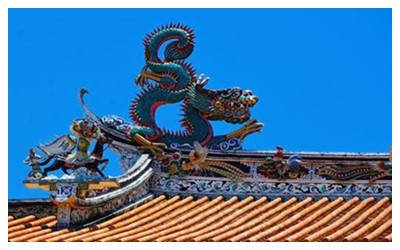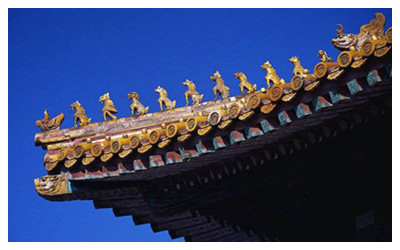- Home
- Travel In China > China Culture > Chinese Architecture >
Wenshou, Zoomorphic Ornament

Wenshou (吻兽) , is name of a beast according to Chinese mythology. Also known as Zoomorphic Ornament, It is a special kind of ornament on the the roofs, main ridges, sloping and branch ridges of Chinese palaces, temples and mansions.
Chiwen ( 鸱吻), is the monstrous thing at either end of the main ridge, appears roughly like the tail of a fish. Fierce and formidable, it looks as if it were ready to devour the whole ridge; so it is also known as the ridge-devouring beast ( Tunji shou) .
According to Chinese mythology, It is one of the sons of the Dragon King who rules the seas. It is said to be able to stir up waves and change them into rains. So ancient Chinese put a Chiwen at either end of the main ridge for its magic powers to conjure up a downpour to put out any fire that might break out. But for fear that it might gobble up the ridge, they transfixed it on the roof with a sword.

At the end of the sloping and branch ridges there are often a string of smaller animals, their sizes and numbers being decided by the status of the owner of the building in the feudal hierarchy. These small animals were also believed to be capable of putting out fires. While this can be easily dismissed as superstition, they do add to the grandeur and magnificence of the imperial buildings.
The largest number of zoomorphic ornaments is found on the Taihe Palace Throne Hall or the Hall of Supreme Harmony of the Forbidden City. Leading the flock is a god riding a phoenix, after whom come a dragon, a phoenix, a lion, a heavenly horse, a sea horse and five other mythological animals, all called by unusual names. Qianqing Palace (the Palace of Heavenly Purity), which the emperor used as his living quarters and his office for handling daily affairs, being next in status to Taihe Palace, has a band of nine animal figures. Still next in importance is Kunning Palace (the Palace of Female Tranquility), which served as the empress's apartments; it has a group of seven zoomorphic figures. This number is further reduced to five for the twelve halls in side courtyards, that used to house the imperial concubines of different grades. Some of the side halls have only one animal figure each on their roofs.
The earliest ridge animals so far discovered in the country came to light in 1960 in a suburban area of Shashi,
Hubei Province. On the interior wall of a roll tile which served as the body of a ridge animal figure was engraved "first year of
Yuanguang," which means the year 134 B.C. It can be seen that installing animal figures on roof-ridges has been an established practice for at least 2,100 years.

 Wenshou (吻兽) , is name of a beast according to Chinese mythology. Also known as Zoomorphic Ornament, It is a special kind of ornament on the the roofs, main ridges, sloping and branch ridges of Chinese palaces, temples and mansions.
Wenshou (吻兽) , is name of a beast according to Chinese mythology. Also known as Zoomorphic Ornament, It is a special kind of ornament on the the roofs, main ridges, sloping and branch ridges of Chinese palaces, temples and mansions. At the end of the sloping and branch ridges there are often a string of smaller animals, their sizes and numbers being decided by the status of the owner of the building in the feudal hierarchy. These small animals were also believed to be capable of putting out fires. While this can be easily dismissed as superstition, they do add to the grandeur and magnificence of the imperial buildings.
At the end of the sloping and branch ridges there are often a string of smaller animals, their sizes and numbers being decided by the status of the owner of the building in the feudal hierarchy. These small animals were also believed to be capable of putting out fires. While this can be easily dismissed as superstition, they do add to the grandeur and magnificence of the imperial buildings. Ask Questions ?
Ask Questions ?